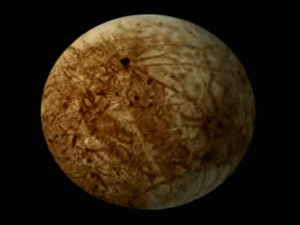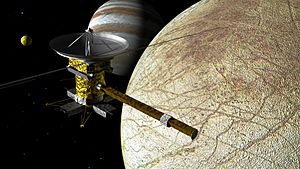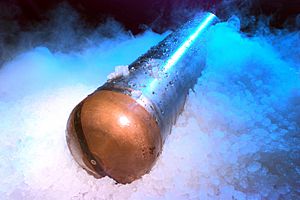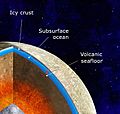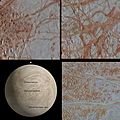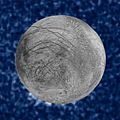Europa (moon) facts for kids
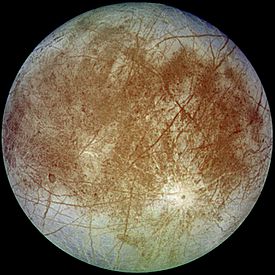
Europa, as seen by the Galileo spacecraft
|
|||||||||
| Discovery | |||||||||
|---|---|---|---|---|---|---|---|---|---|
| Discovered by | Galileo Galilei Simon Marius |
||||||||
| Discovery date | 8 January 1610 | ||||||||
| Designations | |||||||||
|
Named after
|
Ευρώπη Eurōpē | ||||||||
| Jupiter II | |||||||||
| Adjectives | Europan | ||||||||
| Orbital characteristics | |||||||||
| Epoch 8 January 2004 | |||||||||
| Periapsis | 664862 km | ||||||||
| Apoapsis | 676938 km | ||||||||
|
Mean orbit radius
|
670900 km | ||||||||
| Eccentricity | 0.009 | ||||||||
| 3.551181 d | |||||||||
|
Average orbital speed
|
13743.36 m/s | ||||||||
| Inclination | 0.470° (to Jupiter's equator) 1.791° (to the ecliptic) |
||||||||
| Satellite of | Jupiter | ||||||||
| Physical characteristics | |||||||||
|
Mean radius
|
1560.8±0.5 km (0.245 Earths) |
||||||||
| 3.09×107 km2 (0.061 Earths) |
|||||||||
| Volume | 1.593×1010 km3 (0.015 Earths) |
||||||||
| Mass | 4.79984×1022 kg (0.008 Earths) |
||||||||
|
Mean density
|
3.013±0.005 g/cm3 (0.546 Earths) |
||||||||
| 1.314 m/s2 (0.134 g) |
|||||||||
|
Moment of inertia factor
|
0.346±0.005 (estimate) | ||||||||
| 2.025 km/s | |||||||||
| Synchronous | |||||||||
| 0.1° (to Jupiter) | |||||||||
|
North pole right ascension
|
268.08° | ||||||||
|
North pole declination
|
64.51° | ||||||||
| Albedo | 0.67 ± 0.03 | ||||||||
|
|||||||||
| 5.29 (opposition) | |||||||||
| Atmosphere | |||||||||
|
Surface pressure
|
0.1 μPa (10−12 bar) | ||||||||
Europa (also called Jupiter II) is one of the four largest moons orbiting Jupiter. These four moons are known as the Galilean moons. Europa is the smallest of them. It is also the sixth-largest moon in our entire Solar System.
Galileo Galilei discovered Europa in 1610. It was named after Europa, a princess from ancient Greek stories. She was the mother of King Minos of Crete.
Europa is a bit smaller than Earth's Moon. It is mostly made of silicate rock. It has a crust of water ice and likely a core of iron and nickel. Europa also has a very thin atmosphere, mostly made of oxygen. Its surface has many cracks and streaks, but not many craters. Scientists have studied Europa using telescopes and space probes since the 1970s.
Contents
What Makes Europa Special?
Europa has the smoothest surface of any solid object we know in the Solar System. Because its surface looks so young and smooth, scientists think there might be an ocean of water hidden beneath its icy crust. This hidden ocean could possibly be home to extraterrestrial life.
Some parts of Europa's surface might be covered in sea salt from this underground ocean. This suggests the ocean is touching the seafloor. This connection could be important for understanding if Europa can support life. The Hubble Space Telescope has also seen what look like water vapor plumes. These are thought to be like geysers erupting from the moon's surface.
In 2018, astronomers found more evidence of these water plumes. This came from data collected by the Galileo space probe. Galileo orbited Jupiter from 1995 to 2003. Finding these plumes means researchers might be able to study Europa's ocean for signs of life without even landing on the moon! In 2024, scientists also reported that Europa's surface might have less oxygen than first thought.
The Galileo mission gave us most of the information we have about Europa today. No spacecraft has landed on Europa yet. However, several missions are planned for the future. The European Space Agency's Jupiter Icy Moon Explorer (JUICE) launched in 2023. It will fly by Europa twice. NASA's Europa Clipper mission launched in 2024. It will explore Europa to see if it could support life.
How Europa Moves
It takes Europa about 85 hours (which is 3 and a half Earth days) to spin around once on its axis. It also takes Europa the same amount of time, 85 hours, to complete one orbit around Jupiter. Because these times are the same, the same side of Europa always faces Jupiter. This is similar to how Earth's Moon works. That's why we only ever see one side of our Moon!
Europa is "tidally locked" to Jupiter. This means Jupiter's gravity keeps one side of Europa always facing it. Scientists have studied the unique cracks on Europa's surface. They think Europa might have spun with a tilted axis at some point. If this is true, it could explain many of the features we see on Europa. The huge network of cracks on Europa shows the stress caused by Jupiter's massive tides pulling on its global ocean. Europa's tilt could help us understand how much of its history is recorded in its icy shell. It could also tell us how much heat is made by tides in its ocean, and how long the ocean has been liquid.
Europa's Features
Europa is the smoothest object known in the Solar System. It doesn't have large mountains or many craters. It is slightly smaller than Earth's Moon. Europa is about 3,100 kilometers (1,900 miles) across. This makes it the sixth-largest moon and the fifteenth-largest object in the Solar System. Even though it's the least massive of the Galilean moons, it is still more massive than all other known moons in the Solar System combined.
Europa's density suggests it is similar to rocky planets like Earth. It is mostly made of silicate rock.
Scientists believe Europa has an outer layer of water about 100 kilometers (60 miles) thick. Part of this layer is frozen as its crust. The other part is a liquid ocean underneath the ice. Europa likely has a metallic iron core.
The Ocean Under the Ice
Europa's ice shell might be only a few kilometers thick. However, some scientists think that the very top part of the ice crust, which moves with Jupiter's tides, could be as thin as 200 meters (660 feet).
The liquid ocean beneath the ice could be about 100 kilometers (60 miles) deep. This means Europa's oceans could hold two or three times the amount of water found in all of Earth's oceans!
It has been suggested that life might exist in this ocean under the ice. There is no proof of life on Europa right now. However, scientists are very careful to avoid contaminating Europa. For example, the Galileo mission ended by crashing the spacecraft into Jupiter. If it had just been left to float, it might have eventually crashed into Europa. This could have brought tiny organisms from Earth to Europa. If that happened, it would be impossible to know if any life found there was truly native to Europa. It could even harm any existing native life forms.
The radiation levels on Europa's surface are very high. Being exposed to this radiation for just one day would cause severe sickness or even death for humans.
Future Missions to Europa
The idea that extraterrestrial life could exist on Europa has made it a very important target for future space missions. These missions aim to study Europa's chemical makeup and search for life in its hidden oceans. Robotic missions to Europa need to be very tough. They must survive the strong radiation around Jupiter and Europa.
In 2011, a mission to Europa was suggested by a U.S. space science group. Because of this, NASA started studying ideas for a Europa lander, a flyby mission (called Europa Clipper), and an orbiter. The orbiter would focus on ocean science. The flyby mission would focus on the chemistry and energy of Europa.
In 2012, the European Space Agency (ESA) chose the Jupiter Icy Moon Explorer (JUICE) as a planned mission. This mission will fly by Europa twice, but its main focus is on Ganymede.
In 2013, a new idea for the Europa Clipper flyby mission was presented. In 2015, NASA announced it would develop the Europa Clipper mission. They also revealed the scientific tools it would carry. The goal of Europa Clipper is to explore Europa to see if it can support life. It will also help choose good spots for a future lander.
The Europa Lander (NASA) is a newer mission idea that is being studied. Research from 2018 suggests that Europa's surface might have tall, sharp ice spikes. This could make it very difficult for any spacecraft to land safely on its surface.
Images for kids
-
Animation of the Laplace resonance of Io, Europa and Ganymede (conjunctions are highlighted by color changes)
-
Water plumes on Europa detected by the Galileo space probe
-
A black smoker in the Atlantic Ocean. Driven by geothermal energy, this and other types of hydrothermal vents create chemical disequilibria that can provide energy sources for life.
See also
 In Spanish: Europa (satélite) para niños
In Spanish: Europa (satélite) para niños


